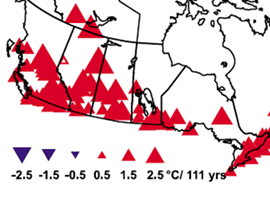| | Climate change is a long-term shift in weather, such as changes in temperature, precipitation or winds. These changes can be gradual or occur rapidly as in extreme events.
.
Greenhouse gases (GHG) in the atmosphere act as a thermostat controlling the earth’s climate. Concentrations of GHGs have been increasing steadily and have been linked to increasing temperatures, higher variability in temperatures and rainfall, as well as increases in extreme weather events. These changes have been shown to be influenced by human activities including industrialization and release of natural carbon sinks by cultivation and deforestation.
Farmers and ranchers are directly affected by changing trends described below. Applying Climate Smart Agriculture principles of increasing production efficiency and lowering greenhouse gases will improve the capacity of farmers and ranchers to bounce back from climate impacts.
Past Trends
Its very challenging to compare historical weather data measured at only a few locations using dated technologies with more data using improved methods. However, generalized comparisons in a study by Shen et al 2005 indicated that increases in temperature and rainfall had occurred since 1985 in Alberta.
- The largest rainfall increases appeared to be in the north, northwest and southeast and appeared smaller in the central and southern parts of Alberta.
- The growing season in northeastern Alberta appeared to have increased by 3 to 9 days and by 0 to 3 days in the Boreal Transition and Aspen Parkland ecoregions.
More recently, Vincent et al (2012) identified trends between 1900 and 2010 of increasing annual mean daily minimum temperatures, with the greatest warming occurring in winter and spring.

Temperature trends between 1900 and 2010. Upward (red) triangles show positive temperature trends and downward (blue) triangles show negative trends, with the size of the triangle indicating the amount of the trend. Source: Vincent et al. 2012
Present Conditions
Temperature, moisture and growing degree days are very different between years and locations in Alberta. Near-real-time climate information collected at more than 350 stations is available from the Alberta Climate Information Service (ACIS).
Possible Future Trends
Agriculture and Agri-Food Canada have studied a number of possible future climates. Most climate change models project the possible warmer future conditions with small increases in precipitation for most regions in the Prairies.
- Warming trends could expand the growing season due to milder and shorter winters, although this could also promote moisture losses from soil and vegetation.
- Timing and amounts of precipitation could also change and extreme events may be more likely.
- Related impacts may include the need for new crop types as well as ways to combat new weeds, insects and diseases.
Preparing for a range of possible future conditions is needed to prevent unfavorable impacts of future climates, see: Agricultural Adaptation Strategies in Alberta.
For More Information
Barrow, E.M. and Yu. G. 2005. Climate Scenarios for Alberta. A Report Prepared for the Prairie Adaptation Research Collaborative (PARC) in co-operation with Alberta Environment, Regina, Saskatchewan.
Kulshreshtha, S.N. 2011. Climate Change, Prairie Agriculture and Prairie Economy: The New Normal. Canadian Journal of Agricultural Economics. 59:19-44.
Prairie Adaptation Research Collaborative of governments of Canada, Alberta, Saskatchewan and Manitoba pursue climate change impacts and adaptation research in the Prairie Provinces.
Schneider, R.R. 2013. Alberta’s Natural Subregions Under a Changing Climate: Past, Present and Future.
Shen, S. S. P., H.Yin, K. Cannon, A. Howard, S. Chetner, and T.R. Karl. 2005. Temporal and Spatial Changes of the Agroclimate in Alberta, Canada, from 1901 to 2002. Journal of American Meteorological Society, 44:1090-1105.
Vincent et al. 2012. A second generation of homogenized Canadian monthly surface air temperatures for climate trend analysis. J Geophysical Research, 177: D18110, at: |
|